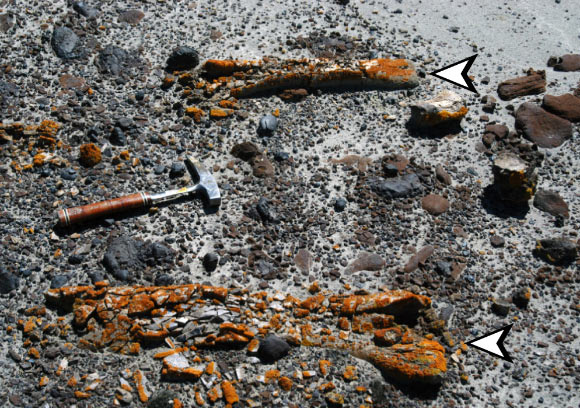Lichens are symbioses between fungi and algae (and/or cyanobacteria) that play important ecological roles and colonize many substrates, including fossils. According to new research, they can serve as biological indicators of fossils in western North America and can be identified using remote sensing.

Preferential colonization of dinosaur bones by lichens. Image credit: Pickles et al., doi: 10.1016/j.cub.2025.09.036.
“This research highlights how modern organisms can help us to find ancient ones,” said Dr. Brian Pickles, a researcher at the University of Reading.
“It’s remarkable to consider that these lichens, essentially miniature ecosystems, are founded upon the remains of dinosaurs that died over 75 million years ago.”
“Using drone technology to detect the spectral signatures of the lichens could potentially revolutionize how paleontologists search for fossils.”
In the study, Dr. Pickles and his colleagues found that two lichen species — Rusavskia elegans and Xanthomendoza trachyphylla — colonized as much as 50% of exposed fossil bones but less than 1% of surrounding rock fragments.
This likely occurs because dinosaur bones provide the alkaline, calcareous, and porous substrates these lichens favor.
“This pattern of lichen growing preferentially on fossil bone has been noted for decades, but never quantified until now,” said Dr. Caleb Brown, a researcher at the Royal Tyrrell Museum of Palaeontology.
“When first encountering high concentrations of exposed fossil bone like bonebeds, it is often the ‘meadow’ of orange lichen that is noticed first, not the bones themselves.”
Using drones with specialized sensors, the authors identified lichen-colonized fossils from aerial images with 2.5 cm pixel resolution.
The lichens exhibit distinct spectral properties, showing lower reflectance in blue wavelengths and higher reflectance in infrared regions.
The method can offer significant advantages for paleontological prospecting, particularly in remote terrain where traditional ground surveys are challenging.
The approach could accelerate fossil discovery while reducing field costs and environmental impact.
The research builds on decades of anecdotal observations by paleontologists.
In 1980, paleontologist Darren H. Tanke speculated that the orange pigmentation of the lichen on Centrosaurus bones might be detectable by satellites — a prediction that seems closer than ever now that they can be found using airborne drone technology.
“This drone study lays the groundwork for mapping much larger areas using aircraft and satellites,” said Dr. Derek Peddle, a researcher at the University of Lethbridge.
“The new lichen indicators we’ve developed will help us find fossils across vast landscapes.”
“It’s exciting to combine our imaging technology with this international team’s expertise to advance dinosaur discovery through remote sensing of lichen.”
The team’s paper was published this week in the journal Current Biology.
_____
Brian J. Pickles et al. 2025. Remote sensing of lichens with drones for detecting dinosaur bones. Current Biology 35 (21): R1044-R1045; doi: 10.1016/j.cub.2025.09.036







